Is Grape a Tropical Fruit? No!
Grapes are not considered tropical fruits. They originate from temperate regions and are cultivated in various climates, not exclusively in tropical zones.
Tropical fruits are typically grown in warm climates near the equator, where conditions are ideal for their growth year-round.
Grapes, on the other hand, originated in the Near East and are now grown in temperate zones across the world.
They require a specific climate with warm, dry summers and cool winters for optimal growth and fruit production.
The cultivation of grapes, known as viticulture, is prominent in regions such as the Mediterranean, California, and France, which are not tropical climates.
Grapes thrive outside the tropics, showcasing their adaptability to temperate climates around the world.
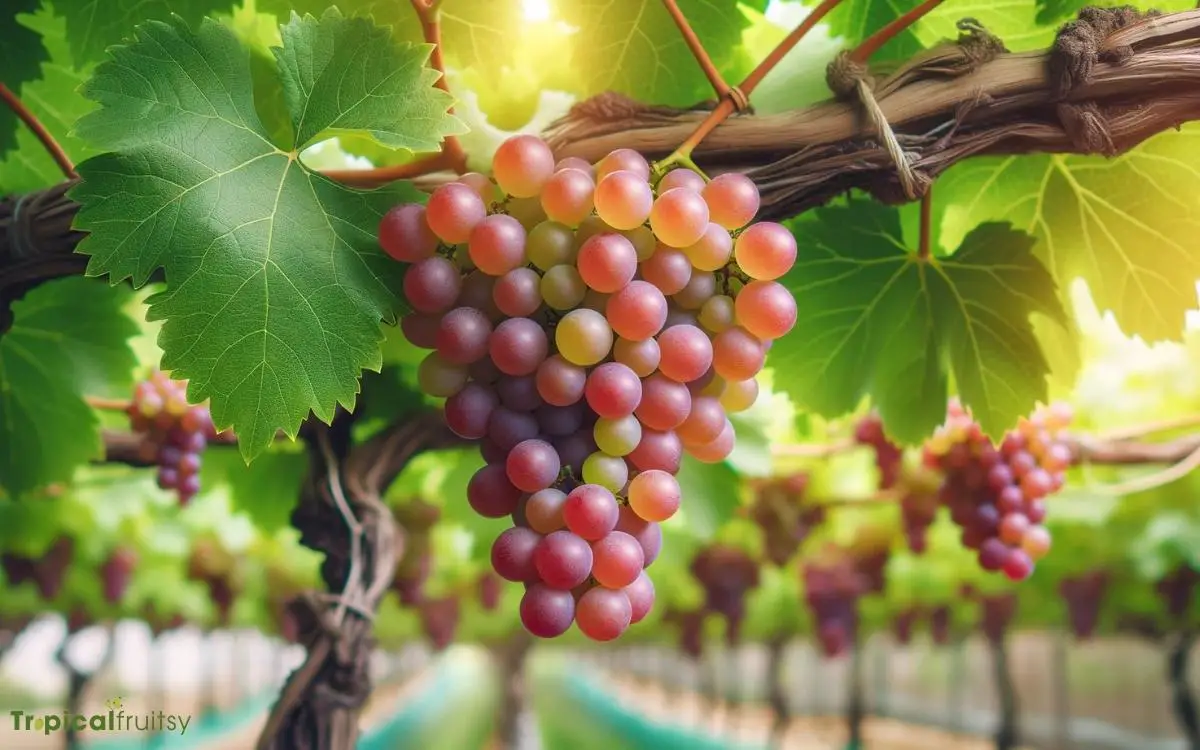
Key Takeaway
5 Classification: Is Grape a Tropical Fruit
| Classification | Tropical Fruits | Grapes |
|---|---|---|
| Climate | Warm, humid equatorial regions | Temperate zones with distinct seasons |
| Origin | Equatorial regions | Near East, temperate regions |
| Year-Round Growth | Yes, in native regions | No, requires a period of dormancy |
| Growing Regions | Southeast Asia, Central America, parts of Africa | Mediterranean, Central Valley of California, Bordeaux |
| Examples | Mango, papaya, pineapple | Various Vitis species |
Defining Tropical Fruits
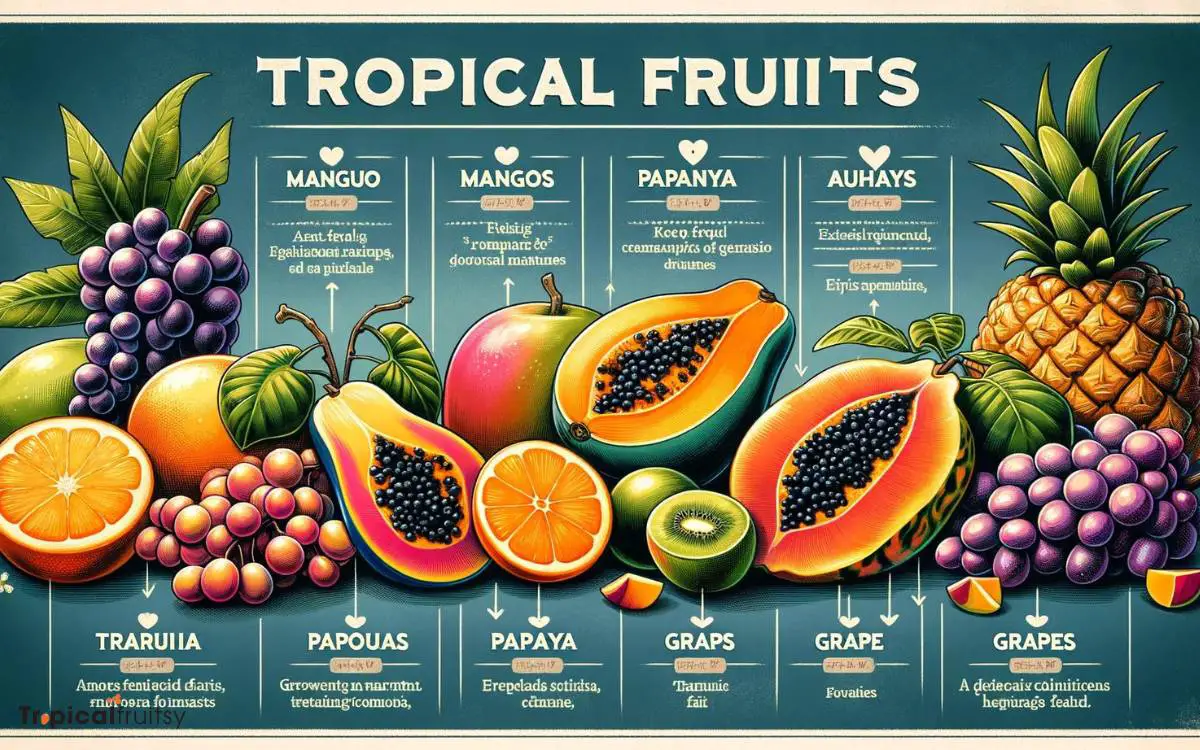
Tropical fruits are typically defined as those that originate and thrive in the warm, humid climates of the Earth’s tropical regions.
These fruits are characterized by their ability to grow in areas that experience minimal temperature variation and are generally frost-free, aiding in the fruits’ development and maturation processes.
Botanists and agricultural scientists categorize tropical fruits based on factors such as their climatic needs, physiological adaptations, and phenological cycles.
These fruits, often rich in vitamins, minerals, and fibers, have adapted to their environments through evolutionary processes that favor certain traits, such as thick skins to prevent moisture loss and vibrant colors to attract pollinators.
Understanding the specific growth requirements and adaptations of tropical fruits sets the stage for discussing the climatic origins and categorization of grapes.
The Origin of Grapes

Amid the diverse family of fruit-bearing plants, grapes (genus Vitis) trace their origins to temperate zones rather than tropical environments.
This distinction is pivotal in understanding the environmental adaptations and the evolutionary history of the grapevine.
Grapes have been cultivated for thousands of years, with evidence pointing to their domestication in the Near East and subsequent spread to other temperate regions around the globe.
Here is a concise overview of grape characteristics and their origins:
| Aspect | Detail | Relevance |
|---|---|---|
| Family | Vitaceae | Broad classification |
| Genus | Vitis | Specific to grapes |
| Preferred Climate | Temperate | Not tropical |
| Domestication Region | Near East | Origin of cultivation |
| Spread | Global | Adaptation to various temperate zones |
The data above underscores that the grapevine thrives under specific climatic conditions that are characteristic of temperate regions, marking a clear distinction from tropical fruits.
Grape Varieties Worldwide

Grapes (Vitis spp.) exhibit a broad spectrum of genetic diversity, which manifests in the multitude of varieties cultivated across various climates and terroirs globally.
The examination of regional grape differences reveals the influence of environmental factors and breeding practices on grape morphology and phytochemical composition.
Popular grape types such as ‘Cabernet Sauvignon’ and ‘Chardonnay’ have achieved widespread recognition, while unique local cultivars contribute to the rich viticultural tapestry by offering distinctive flavors and adaptations to local conditions.
Regional Grape Differences
Commonly, grape varieties display marked differences that are closely tied to the climatic and geographical conditions of their respective regions of cultivation.
These regional differences lead to a vast diversity in grape characteristics, which are critical for the production of distinct wine profiles.
To elucidate these regional disparities, consider the following:
- Vitis vinifera in Europe thrives in temperate climates, producing grapes with varied tannin levels for wines like Cabernet Sauvignon and Chardonnay.
- Concord grapes in North America, suited to colder environments, yield robust flavors for juices and jellies.
- South African Chenin Blanc, optimized for warmer, drier climates, develops high acidity and fruity flavors.
- Shiraz or Syrah grapes, cultivated extensively in Australia, are known for their bold, spicy notes, a result of the region’s intense heat and sunlight exposure.
Popular Grape Types
While many grape varieties have adapted to a range of climates, some of the most popular types cultivated around the world include Cabernet Sauvignon, Merlot, and Pinot Noir for red wines, as well as Chardonnay, Sauvignon Blanc, and Riesling for white wines.
These cultivars exhibit a wide array of phenotypic characteristics, including berry size, skin thickness, and flavor profiles, which are influenced by genetic composition and environmental factors.
Viticulturists select varieties based on suitability to local climate conditions, disease resistance, and market preferences.
The Cabernet Sauvignon grape, for instance, is known for its thick skin and high tannin content, which contribute to the longevity and structure of the wines produced.
Conversely, Pinot Noir grapes have thinner skins and lower tannin levels, resulting in lighter, more delicate wines.
Unique Local Cultivars
Beyond the widely known grape varieties, numerous local cultivars each with unique characteristics shaped by their terroirs enrich the global viticulture landscape.
These cultivars often exhibit distinctive traits that reflect the environmental conditions and cultural practices of their regions of origin.
- Assyrtiko – Native to the volcanic soils of Santorini, Greece, this cultivar is known for its high acidity and mineral profile, which contributes to the production of crisp, dry white wines with citrus and flinty notes.
- Norton – Found predominantly in the United States, particularly Missouri, Norton grapes are celebrated for their disease resistance and robust, spicy red wines that often possess complex berry and earthy undertones.
- Tannat – Originally from Southwest France, now a cornerstone in Uruguay’s wine industry, Tannat is famed for its high tannin content and deep color, yielding rich, full-bodied wines with notable aging potential.
- Zweigelt – A cross between Blaufränkisch and St. Laurent, this Austrian variety is versatile, producing wines that range from light and fruity to more substantial and tannic expressions, typically with a characteristic cherry flavor.
Climate Requirements for Grapes
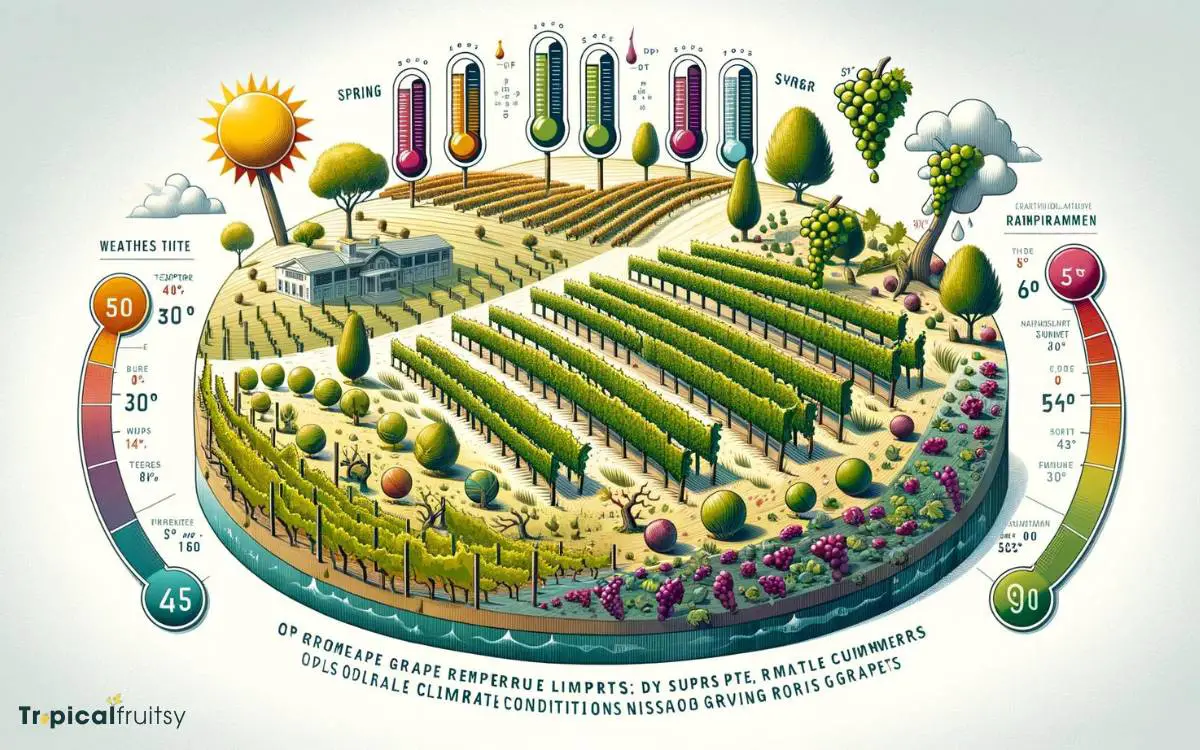
Grapes typically thrive in temperate climates with warm, dry summers and cool winters, which are essential for the dormancy period and subsequent fruit development.
The phenological stages of grapevines from bud break to fruit set, veraison, and final ripening rely on specific climatic conditions for optimal progress.
A delicate balance of diurnal temperature variations is critical, promoting the synthesis of anthocyanins and tannins crucial for the quality of wine grapes.
Precipitation patterns also play a pivotal role; excessive moisture, especially near harvest, can precipitate fungal diseases and dilute fruit flavors.
Thus, viticulturists meticulously monitor and often manipulate the microclimate using techniques such as canopy management to ensure the ideal interplay of sunshine, temperature, and moisture—the triad governing the vine’s vegetative and reproductive cycles.
Grapes Vs. Tropical Fruits
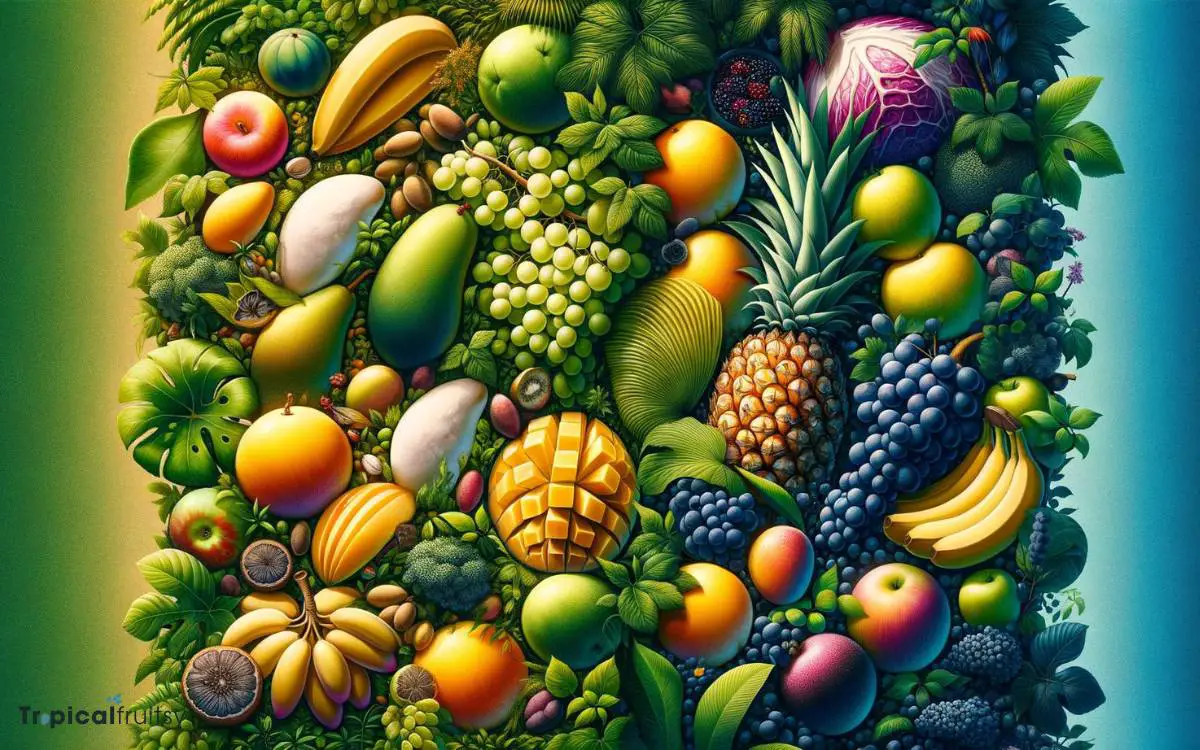
In contrast to the numerous fruits classified as tropical, grapes are not typically included in this category due to their differing climatic preferences and growth patterns.
Here is a detailed comparison:
- Climatic Zones: Grapes thrive in temperate climates with warm, dry summers and mild winters. In contrast, tropical fruits require a consistently warm environment with little variation in temperature throughout the year.
- Frost Tolerance: Grapes can endure and often require a period of dormancy facilitated by colder temperatures, which is not a condition conducive to the growth of tropical fruits.
- Growth Cycle: Grapes have a distinct annual growth cycle, including a period of dormancy, while many tropical fruits grow continuously as long as conditions remain warm and moist.
- Sunlight Exposure: Grapes necessitate high levels of sunlight for optimal sugar development, whereas tropical fruits can often tolerate and sometimes prefer partial shade conditions.
Harvesting Seasons Explained

Although grapes are not classified as tropical fruits, their harvesting seasons are markedly different from those of tropical fruit varieties, typically occurring during the late summer to early fall in temperate regions.
The phenological development of Vitis vinifera, the primary species cultivated for grape production, is influenced by a multitude of climatic factors, including temperature, sunlight exposure, and precipitation patterns.
These variables play a determinative role in the timing of viticultural milestones such as bud break, flowering, veraison (the onset of ripening), and ultimately, harvest.
The precise period for harvesting grapes is critical, as it affects not only the yield but also the sugar content, acidity, and flavor profile of the grapes, which are essential for the quality of fresh grape consumption and winemaking.
Grapes in Culinary Uses

How do the unique harvest timings of grapes influence their utilization in the culinary world?
The phenological stages of grape development, from bud break to veraison, culminate in harvest periods that are meticulously timed to optimize the balance of acids, sugars, and phenolic compounds essential for diverse culinary applications.
This precise timing affects their culinary uses as follows:
- Fresh table grapes are harvested at peak ripeness for immediate consumption, ensuring optimal sweetness and texture.
- Wine grapes are picked based on desired acidity and sugar levels, which vary depending on the wine style being produced.
- Raisins require grapes to be overripe with concentrated sugars before undergoing the drying process.
- Culinary varieties intended for preserves or jellies are selected for their high pectin content and flavor profile.
This precise utilization underscores the versatility of grapes in the culinary realm, setting the stage for a conclusive evaluation in the following section.
Is Persimmon a Tropical Fruit Similar to Grape?
The truth about persimmon as a tropical fruit is worth unlocking. While it shares some similarities with grapes in terms of sweetness and texture, persimmons are grown in temperate climates as well. This exotic fruit is known for its vibrant color, unique flavor, and numerous health benefits.
The Verdict on Grapes
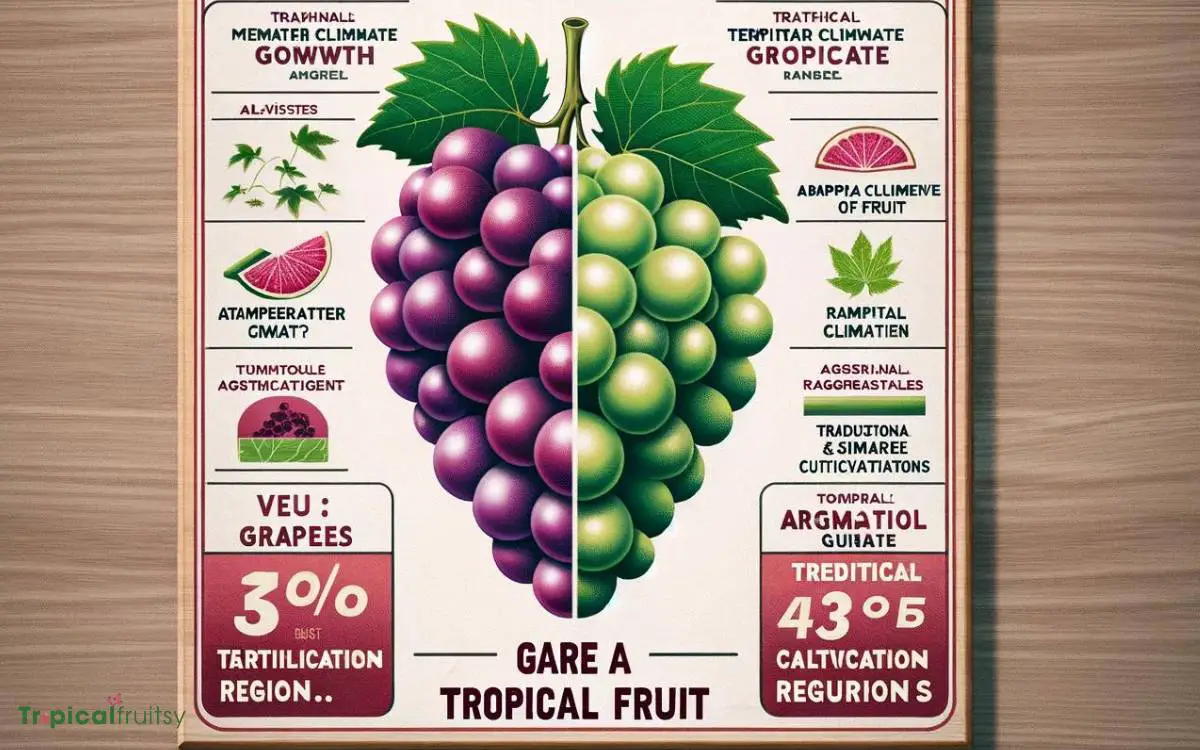
Upon evaluating the botanical classification of grapes, one must examine the scientific taxonomy and the growth patterns of the Vitis genus to determine its proper categorization.
The climatic preferences of grapevines, which thrive in temperate zones, are a critical factor in assessing their compatibility with tropical environments.
Comparing these characteristics against established criteria for tropical fruits will yield a conclusive classification of grapes within the context of regional fruit categorization.
Grape Classification
Grapes are classified as a non-tropical, temperate fruit, thriving best in regions with warm summers and cool winters.
Their growth and development are influenced by various climatic and geographic factors, which can be detailed as follows:
- Geographical Range: Primarily found between the 30th and 50th parallels in both the Northern and Southern Hemispheres.
- Temperature Requirements: Optimal growth occurs at 15-30°C (59-86°F), with dormancy induced by cooler temperatures.
- Vernalization: A period of cold winter temperatures is essential to complete the dormancy cycle and ensure proper budbreak.
- Sunlight Exposure: Adequate sunlight is crucial for photosynthesis, influencing sugar accumulation and flavor development in the berries.
Understanding these factors is key to cultivating grapes successfully, a transition that leads us to explore the specific climate preferences for grape cultivation.
Climate Preferences
The optimal climate for grape cultivation encompasses regions with a quantifiable range of temperature variation, ensuring the necessary cold period for dormancy and the warm summers for fruit development.
Viticulture thrives in temperate climates where a marked contrast between day and night temperatures contributes to the balance of acids and sugars in the grape berries, which is crucial for high-quality wine production.
Moreover, the degree of humidity, annual rainfall, and the timing of these climatic events play a significant role in the health and yield of grapevines.
| Climate Factor | Impact on Grape Cultivation |
|---|---|
| Temperature Range | Determines dormancy and fruiting |
| Day/Night Variation | Affects sugar and acid development |
| Humidity | Influences disease pressure |
| Annual Rainfall | Impacts soil moisture and vine health |
| Frost Occurrence | Can damage buds and affect yield |
This table encapsulates the key climatic elements for successful grape cultivation, highlighting the nuanced requirements that define the suitability of a region for viticulture.
Tropical Fruit Criteria
When determining whether grapes qualify as tropical fruits, it is essential to consider several botanical and climatic criteria.
To clarify the classification of grapes, consider the following factors:
- Climatic Zone of Cultivation: Tropical fruits typically thrive in regions near the equator, characterized by consistently warm temperatures year-round. Grapes, however, grow in temperate zones with seasonal temperature variations.
- Growth Cycle: Tropical fruits often have a continuous growth cycle, while grapes have a dormant period influenced by cooler temperatures.
- Frost Tolerance: Tropical fruits are usually sensitive to frost, whereas grapes can withstand and sometimes require a chill period for optimal fruiting.
- Botanical Family: Many tropical fruits belong to specific families such as Musaceae or Annonaceae. Grapes are part of the Vitaceae family, not typically associated with tropical fruits.
Conclusion
Grapes do not fall within the typical classification of tropical fruits. They thrive in temperate climates and differ significantly from their tropical counterparts in both growth requirements and seasonal cycles.
Symbolically, while tropical fruits are often associated with the sun’s lavish energy, grapes are akin to the subtler transitions of temperate zones, embodying a versatility that allows them to flourish across diverse geographical landscapes.
This distinction is vital for understanding agricultural practices and fruit cultivation.






